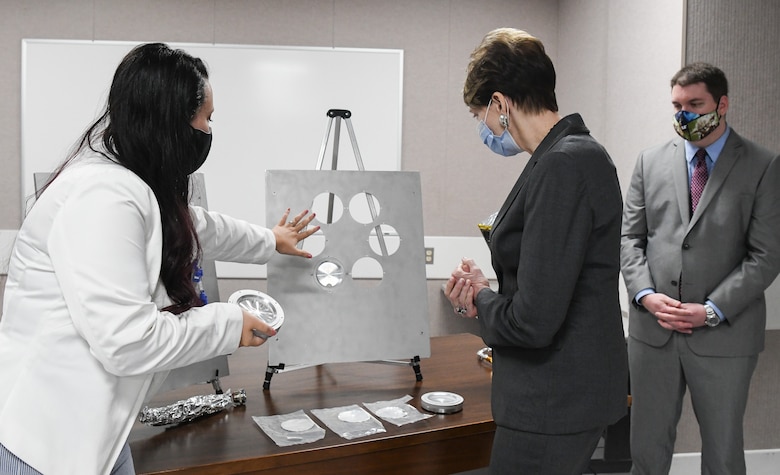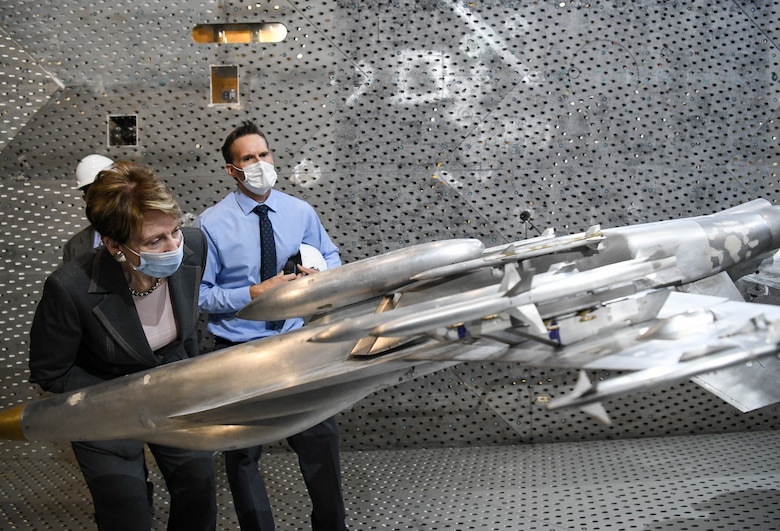Secretary of the Air Force Barbara Barrett visited Arnold Air Force Base June 18 to get a first-hand look at critical ground-based developmental test mission activities.
The visit highlighted the contribution of the Arnold Engineering Development Complex team to a variety of national priority test missions such as nuclear modernization, flight vehicle aerodynamics, aero propulsion, hypersonic and space systems.
"Testing and analysis conducted at Arnold Engineering Development Complex are driving scientific breakthroughs to advance our next-generation capabilities," Barrett said. "Historically, innovations by Arnold Airmen led to the fielding of the F-22 (Raptor), F-35 (Lightning II), and many more aircraft. Now, as we saw today, these teams are developing cutting-edge technology and platforms to build and equip our future Air and Space Forces."
Barrett visited the Space and Missile Test Branch, where she saw the Space Threat Assessment Testbed, a ground test facility used to evaluate the performance of materials, components, subsystems, and small satellites in a test environment capable of providing space-like conditions from low Earth orbit to geosynchronous operations.
She was shown the High-Enthalpy Arc-Heated Facilities, which provide aerothermal ground test simulations of hypersonic flight over a wide range of velocities and pressure altitudes in support of materials and structures development.
The Space and Missile Test Branch also took Barrett to the J-6 Large Rocket Motor Test Facility, where she was briefed on the support the AEDC team provides to current and future strategic nuclear deterrent missile systems.
Barrett was shown the Hypersonic Test Capability Improvement Project, nicknamed "Project Phoenix," in which the High-Speed Systems Test Technology Branch will bring online a facility to support research and development of future hypersonic weapon acquisition programs. The project will be completed in two blocks - each will provide a world-unique test capability. The first block will provide clean Mach 6 airflow to test hypersonic air-breathing engines. The second block will provide a variable nozzle and increased Mach to support future technologies.
Barrett also visited the 16-foot Transonic Wind Tunnel which the Flight Systems Test Team uses to conduct aerodynamic testing of large-scale aircraft models. Strategic and tactical weapon systems critical to the Air Force's modernization plan and the 2018 National Defense Strategy have been tested and evaluated in 16T. Some programs tested are the F-22, F-35, F-18, B-1 Lancer, B-52 Stratofortress and Long Range Stand Off. She was also briefed on the pending return to service of the 16-foot Supersonic Wind Tunnel to support future Air Force modernization projects.
"It is a great pleasure to get to showcase our amazing people and capabilities," said Col. Jeffrey Geraghty, AEDC commander. "I'm grateful that Secretary Barrett took the time to see first-hand our team's contribution to the National Defense Strategy."

Kellye Burns, left, a space test engineer, shows Secretary of the Air Force Barbara Barrett some of the hardware and samples used during a materials test in teh Space Threat Assessment Testbed at Arnold Air Force Base, Tenn., June 18, 2020. Also pictured is John Claybrook, capability manager for Space Asset Resilience. (U.S. Air Force photo by Jill Pickett)

Maj. Christopher Brunelle, director of operations for the Arnold Engineering Development Complex Space and Missile Branch, explains the construction of an arc heater to Secretary of the Air Force Barbara Barrett during her visit to Arnold Air Force Base, Tenn., June 18, 2020. Arc heaters provide high-enthalpy test environments to test materials and other means of thermal protection. (U.S. Air Force photo by Jill Pickett)

Secretary of the Air Force Barbara Barrett looks at a model of an F-18 Super Hornet in the Arnold Engineering Development Complex 16-foot Transonic Wind Tunnel during her visit, June 18, 2020, to Arnold Air Force Base, Tenn. Also pictured is Dr. Rich Roberts, flight commander for store separation. (U.S. Air Force photo by Jill Pickett)






